 | |
| The chapel of Santa Barbara is at the top of the hill. |
 |
| Is that door colored "Barichara Green?" |
When you enter the city of Barichara, the
very first colors you see are white buildings with dark green trim including
the doors and windows with terra cotta tiles on the rooftops.
 |
| The plaza is laid out in a NESW square; here you are looking west. |
I am not sure
when these colors first came into existence, but they are considered the ‘original’
colors of the village along with dark brown or, in a few cases, dark blue.
All
around the central plaza, that is the only acceptable color. There are places
like the Mayor’s office with wood doors and windows that have been stained
darker or oiled, but if you want to see more color, other than flowers and
plants, you will have to look a little farther.
 |
| The only truly 'yellow' doors & windows I found. |
On the outer fringes of the city, people have gotten bolder and more colorful.
 |
| This faded blue door is one I noticed when I first came here. |
I recently roamed around and found many
variations of the basic brown, green and blue, as well as white, black, ochre, lavender
and pink, but no red doors. When I asked someone who has been here for 20 +
years about this, she said "Oh no, this would never do. Red is a political
statement." Except with flowers.
Here is an updated link to the 2012 FICBA site, so you can check in to see what the offerings and activities are. If you are planning to be here for the film festival and you don't have a room yet, contact the Casa de Cultura as they may have people who will open up a room in their home for that weekend.
Here is an updated link to the 2012 FICBA site, so you can check in to see what the offerings and activities are. If you are planning to be here for the film festival and you don't have a room yet, contact the Casa de Cultura as they may have people who will open up a room in their home for that weekend.
 |
| Brilliant blue, like the skies some days. |
 |
| Purple, purple door - I love it! |
When the village was designated a national monument in 1975,
it was determined that certain standards of color and design would be adhered
to within the village, even with houses which were being reconstructed or added
as new houses to existing lots. Thus, like nationally protected villages or
structures in the U.S., there is a board of over-seers who make sure when you
arrive, you are visually transported back 400 years. It is worth the trip.











